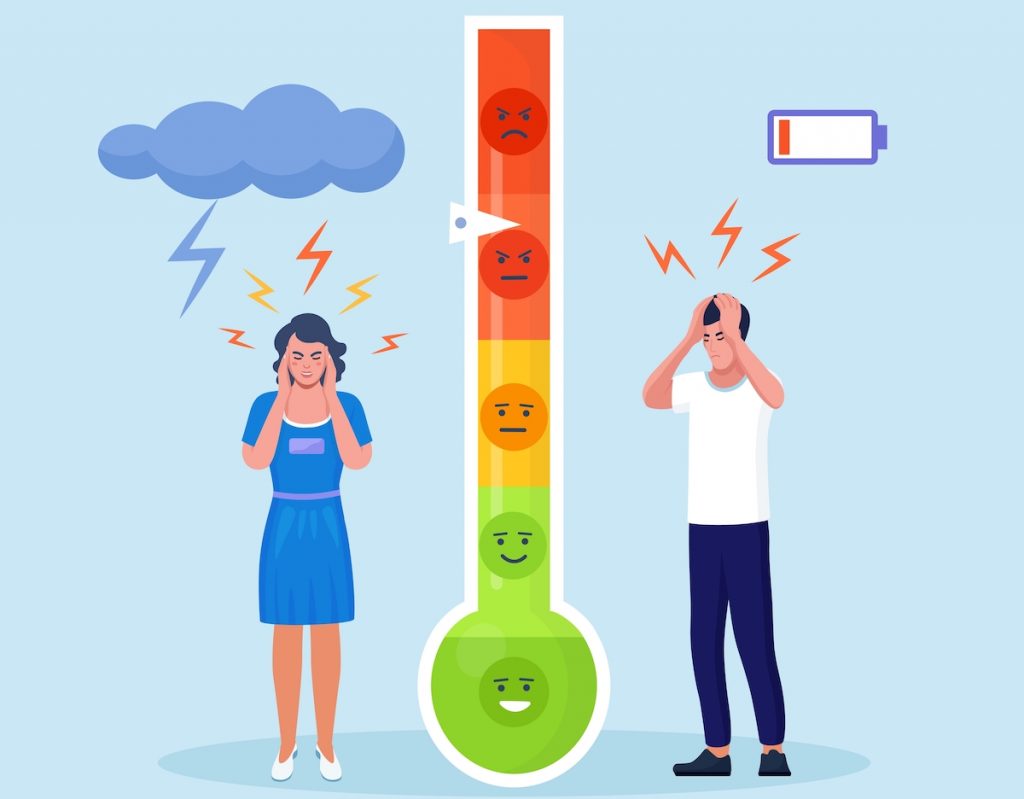
Having a baby is a hugely significant event for parents. It is natural to experience a range of emotions during pregnancy and after, with greater risk of developing a mental health problem during this stage (MIND, 2020).
Postnatal depression is more than feeling unhappy or the ‘baby blues’ that are very common but usually short-lived. It can impact people in different ways, but generally speaking some of the most common symptoms are unhappiness, hopelessness, feeling tearful, and losing interest in the things you once enjoyed. For depression to be diagnosed the symptoms usually need to be persistent and significant for weeks and months (NICE, 2022).
One in ten new mothers and fathers experience clinical levels of depression. You might be surprised to learn that less severe ‘subclinical’ but problematic low mood may impact perhaps one in two during this time. Furthermore, it is common for problems to co-occur in couples with young children, and perhaps up to 50% of the time, both will have symptoms at the same time.
Research has shown that there is an association between parental depression and emotional difficulties in infants and that these can persist into adolescence. What has been less understood is how this might occur: besides the ‘presence’ or ‘absence’ of a ‘diagnosis’, often taken via a mean cut-off score on a depression scale, is there a mechanism through which some symptoms in parents might induce these difficulties? Writing in the British Journal of Psychiatry, Martin et al (2023) set out to explore just that.

One in ten new mothers and fathers experience clinical levels of depression.
Methods
The sample was considered broadly representative of the general population with 4,492 Mother-Father-Child trios recruited from a prospective population-based cohort in the UK. This came from the well-known Avon Longitudinal Study of Parents and Children (ALSPAC) that is regarded as a highly representative sample of the UK population.
A Network Analysis (NA) framework was used to explore symptom patterns/clusters of cognitions and behaviours, and to see how they might influence each other. This also looked for any underlying co-occurrence of depression in parents and how it was associated with their child’s well-being and any emergent emotional difficulties. The real strength of NA is that it can look ‘beyond’ those average scores on scales, and take individual symptoms, or clusters of the same, across large groups of participants. This allows putative feedback loops to be explored. The example the authors of the paper give is how insomnia can cause fatigue, which in turn can impact the body and its movements, which can complete the loop by further adversely impacting sleep.
The Edinburgh Postnatal Depression Scale (EPDS) was used to measure parents’ symptoms of depression when the infant was 21 months old, while the Strength and Difficulties Scale (SDQs) was completed by mothers and used to measure any emotional difficulties the children might have when they were 9, 11 and 13 years of age.
The NA aimed to look for ‘bridge’ symptoms that might act as connections between parents and children. For example, might insomnia in mothers impact a sense of guilt in them or their partners? The reason this is potentially so useful is that it might aid therapy. Consider this earlier example; should it prove to be true, then clinicians might focus efforts on improving sleep hygiene rather than a more ‘global’ effort through, say, an antidepressant medication.
In these analyses, symptoms were represented by ‘nodes’ in the network, with edges between them representing conditional associations. An algorithm plotted symptoms with the strongest symptoms together in the graph’s middle. Clustered ‘communities of symptoms’ were defined, and bridges between them assessed for strength and stability.
Results
Co-occurrence of depression symptoms between parents
- The results showed that symptoms among parents intercorrelated, with very similar clustering patterns. In particular, panic, worry and guilt clustered in both mothers and fathers.
- The same symptoms in mothers and fathers had the greatest influence on the total network. For example, sadness and feeling overwhelmed were the most highly connected symptoms across the entire network for both mother and fathers.
- Of interest, the study also found that symptoms, when higher in one parent, were also higher in the other parent. It suggests that there can be a concordance of depression, and problem types, between parents.
- Guilt and self-harm ideation were two main bridging symptoms activated in both parents. This meant that these two key symptoms reinforced similar feelings in the other partner.
How parents’ depression can be linked to emotional difficulties in children
- The results showed that sadness, panic, anhedonia and feeling guilty among mothers were directly associated with subsequent child emotional difficulties.
- For fathers, it was only the feelings of being overwhelmed that was directly associated with emotional difficulties in children.

This study found that both mothers and fathers may experience similar levels of depression at the same time, impacting one another.
Conclusions
The authors concluded that parents can experience similar symptoms of depression at the same time, and if one parent struggles with particularly high levels of distress then it is likely to impact and activate the other parent to experience related such levels.
Although the study found an association between parents’ depression and the child’s emotional difficulties, the type of depressive symptoms were not the same for each parent. The findings may help clinicians identify key symptoms to target and aid recovery in parents and children.

Different maternal and paternal depressive symptoms were associated with emotional difficulties in children.
Strengths and limitations
This was the first study to use Network Analysis to understand the intergenerational patterns of depression within families; existing research has tended to focus more on symptom severity or a binary diagnosis presence/absence on an individual level. This unique methodology opens the door for new knowledge and understanding around the predisposing, precipitating and perpetuating factors around depression on an individual and systemic level. For example, the current study has provided clinical insight in to why we often see children experiencing emotional difficulties when there is a parent who presents as withdrawn or less nurturing due to the nature and impact of depression. It highlights the importance of collecting a family history of mental health during assessments to formulate and treat mental health difficulties comprehensively among children, and/or families as a whole.
Establishing that guilt and self-harm are two symptoms which are connected and easily reinforced between mothers’ and fathers’ depression, and similarly maintaining their child’s emotional difficulties, seems particularly helpful, especially when a clinician might want to target key symptoms in a treatment plan. However, the research did not include whether there was, or could be, a particular symptom or pathway being directed or influential from child to parent: namely, can a child’s emotional difficulties reinforce or activate similar feelings in their parents, and if so, what are the key behaviours, emotions or cognitions, and are they different with each parent?
This study only had mothers completing the SDQs as a way to measure the child’s emotional difficulties. Although this probably reflects how the measure is usually administered within the clinical word, from a research point of view, I wonder why fathers were not involved with the reporting and what impact biases this might have had. Research has shown that mother and fathers generally score similarly on the SDQ; however, fathers are more likely to score higher for externalising behaviours – e.g. hyperactivity – than mothers (Davé et al., 2008).
The study suggests that combining parental (and possibly school) reports in clinical settings would enhance sensitivity of identifying children requiring clinical attention for their problem behaviours.
To develop a more accurate picture of the network structure in familial depression, analysing how each family understand and report their depression, and how each family member can influence the progression and direction of depression within the family unit can provide useful insights into nature of intergenerational depression.
This study used the EPDS to measure depression among mother and fathers. This scale was originally designed to screen mothers who are likely to experience depressive symptoms after giving birth, and it is the most commonly used tool in perinatal care. However, this again leaves me wondering what about fathers? Existing research (Matthey et al., 2001) suggests that the clinical cut-offs might need to be adapted to fathers given how depression can present differently to mothers during the postnatal period, to which this study did find and report.
The EPDS was only administered when infants were 21 months old, while the child measures were repeated at various timepoints: 9, 11 and 13 years of age. I wonder if we would have a better understanding of familial depression and trajectory of the illness if parent measures had been repeated at the same time points.

It’s worth considering why data on child emotional difficulties was collected by mothers’ perspectives, whilst the father’s voices are missing.
Implications for practice
By investigating parents’ depression and how it can be associated with children’s emotional difficulties, this study showed that if untreated, mental ill-health can have significant long-lasting effects on the mother, father and children.
As this study points out, the activating and associating depressive symptoms between family members can be targeted for more rapid recovery, and may be key to identifying who might be more at risk of developing depression in young children, and later unintentionally influencing the transmission of depression.
Although symptom recognition is only one part of the clinical presentation (and we know that a child might feel depressed but, superficially, they could be considered to be functioning ‘relatively well’ by attending school, eating well and so forth), the findings demonstrate how treatment plans could be tailored to target and challenge the problematic behaviours and cognitions that might be maintaining depression on an individual and family level.
The study highlights the importance of working with all family members and considering the interpersonal aspects when formulating intergenerational depression. Not least, this could involve identifying and challenging repeated patterns; maladaptive and adaptive ones might create meaningful change and help stop depression in its tracks, or at least support reducing its severity.
This research reinforced the less studied issue, and one often less considered by the public at large, that depression is common among fathers and that they can react differently to mothers when becoming a parent. For example, fathers commonly felt more overwhelmed and this particular emotion was associated with their child’s emotional difficulties.
As a clinical psychologist working in CAMHS, I find this outcome particularly interesting because I often notice fathers being absent from appointments. The reasons behind this observation might vary from family to family, but I question whether the stigma around men’s mental health and male identity could be contributing to it. I wonder if fathers find it hard to speak out to healthcare professionals because they believe the focus should be on the mother and if ‘traditional’ models of fatherhood or masculinity risk having them feel as though they should ‘hold it together’ for the sake of the mother and child. This speculating seems to be consistent with this current study whereby a father’s sense of feeling overwhelmed could be linked with the belief of ‘feeling trapped with certain responsibilities’ when a child is born.
Interestingly, the NHS risks reinforcing this narrative because services tend to be equipped, or familiar, with supporting the mother and baby/young child or teenager. In my experience, what you often see in Perinatal Mental Health Services (PMHS) is predominantly mothers and children presenting to appointments, with just mothers therefore routinely screened for depression and anxiety during the various antenatal, postnatal and perinatal appointments. There seems to be less oversight over fathers and how they are doing. How are we to gather a sense of fathers’ experiences if they are not accessing or engaging with perinatal services? The NHS Long Term Plan is trying to improve the access to mental health within PMHS, and therefore to routinely screen mothers’ and partners’ mental health during the various health appointments, and support and signpost them to evidence-based psychological interventions when appropriate (Plan.,2019).
Having said that, I recently accessed perinatal mental health support following the trauma I experienced with my first born. When I said to my worker that my partner was also struggling with his own mental health following the birth of our son, and that together we were struggling as a couple and a family, to my surprise, she said ‘I am sorry, but we can only prioritise women at the moment and your partner will have to access support from more generic mental health services’. This is not to directly criticise the professional or team involved: as an NHS clinician, I recognise that they are working to service constraints and resource limitations. Nevertheless, I admit that I was shocked by this and thought not only is there an inequality among mothers and fathers accessing perinatal mental health, but my partner was effectively having to access perinatal support from a non-perinatal specialist. Although a good mental health worker does not have to be a specialist in every aspect of mental health, I would argue that there are certain difficulties which requires a particular set of skills and knowledge.
Research shows that fathers’ brains physically change during and after their child is born (as do mothers’ brains), and fathers also have emotions that are operating in a very different way to usual.
This paper is particularly good at recognising that fathers play a key role in maintaining depression within the family, and I would add that fathers’ voices and experiences need to be explored more within perinatal services. This would ideally reflect whether the services’ are meeting the family needs, and whether more needs to be done in terms of creating a safe environment for fathers or partners to engage with, and benefit from.

Systemic practices in CAMHS settings can help develop a more comprehensive understanding of family history and intergenerational mental health patterns.
Statements of interest
No conflicts of interest to declare. This article was highlighted by Dr Derek Tracy in the monthly BJPsych highlights.
Links
Primary paper
Martin AF, Maughan B, Konac D, Baker ED. Mother and father depression symptoms and child emotional difficulties: a network model. BJPsych, 2023; 222(5):204-211.
Other references
Davé, S., Nazareth, I., Senior, R. and Sherr, L. (2008). A Comparison of Father and Mother Report of Child Behaviour on the Strengths and Difficulties Questionnaire. Child Psychiatry and Human Development, 39(4), pp.399–413.
Matthey, S., Barnett, B., Kavanagh, D.J. and Howie, P. (2001). Validation of the Edinburgh Postnatal Depression Scale for men, and comparison of item endorsement with their partners. Journal of Affective Disorders, 64(2-3), pp.175–184.
MIND (2020). About maternal mental health problems.
NICE (2022). Recommendations | Depression in adults: treatment and management | Guidance.
Plan, N.L.T. (2019). Perinatal mental health services. NHS Long Term Plan.
Photo credits
- Photo by Patricia Prudente on Unsplash
- Photo by Caroline Hernandez on Unsplash
- Photo by engin akyurt on Unsplash
